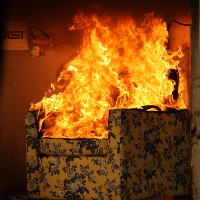State Heeds Warnings about Toxic Furniture Flame Retardants It Championed

A week after Governor Jerry Brown joined a chorus of critics urging state regulators to reduce toxic flame retardants in furniture, the woman who heads the agency responsible for the 1975 fire-safety rule says she wants it scrapped.
Tonya Blood, chief of the Bureau of Electronic Appliance Repair, Home Furnishing and Thermal Insulation, said it would be sufficient to have furniture fabric resistant to a smoldering cigarette rather than have foam cushions that are candle-fireproof. California, which was in the forefront of requiring flame retardant products, has become a critical battleground for efforts to reduce their prevalence in American homes.
Chemical companies have pushed hard for flammability standards that result in the use of toxic chemicals by furniture manufacturers looking for the cheapest way to make their products. Some of the chemicals have been linked to cancer, neurological deficits, developmental problems and impaired fertility that end up in the bodies of people and animals and stay in the environment for years. Studies show Californians have among the highest levels of flame retardants in their bodies worldwide.
A pilot study published in 2011 showed pregnant women at San Francisco General Hospital had among the highest levels in the world of flame retardant polybrominated diphenyl ethers, or PBDEs. The chemicals can still be found in products used today, although a state ban on two widely used P
Several attempts to change the state’s flammability standard have been thwarted by the chemical industry, including legislation last year that would have allowed manufacturers to choose between the candle-foam test and the cigarette-fabric standard. The Citizens for Fire Safety—a nonprofit group that calls itself a “coalition of fire professionals, educators, community activists, burn centers, doctors, fire departments and industry leaders” but is actually supported by the chemical industry—sent its star lobbyist, Dr. David Heimbach, to the state Senate to successfully plead its case that the bill be rejected.
In a devastating series of articles earlier this year, the Chicago Tribune outlined how Dr. Heimbach’s tear-jerking testimony about a 7-week-old baby being burned in a fire started by a candle while she lay on a pillow—“a tiny little person, no bigger than my Italian greyhound at home . . . ultimately died after about three weeks of pain and misery”—was just one fabricated story in “a decades-long campaign of deception.”
Flame retardants are big business. Citizens for Fire Safety is just one of a string of industry groups around the world that work to expand the market for flame retardants in furniture and electronics. Worldwide demand for the products has skyrocketed to 3.4 billion pounds in 2009 from 526 million pounds in 1983, according to The Freedonia Group. The market researchers project that demand will reach 4.4 billion pounds by 2014.
New regulations could be ready in draft form for review by early to mid-August, but it is expected to take a year before actual changes take effect.
–Ken Broder
To Learn More:
Key Agency Moves to Scrap Rules That Made Toxic Flame Retardant Common in U.S. Furniture (by Patricia Callahan, Chicago Tribune)
Chemicals in Furniture Target of Calif. Lawmakers (by Victoria Colliver, San Francisco Chronicle)
“Chemicals of Concern” List Still on Hold after 21 Months of Chemical Industry Lobbying (by Matt Bewig, AllGov)
Chemical Companies, Big Tobacco and the Toxic Products in Your Home (Chicago Tribune)
Fear Fans Flames for Chemical Makers (by Patricia Callahan and Sam Roe, Chicago Tribune)
- Top Stories
- Controversies
- Where is the Money Going?
- California and the Nation
- Appointments and Resignations
- Unusual News
- Latest News
- California Forbids U.S. Immigration Agents from Pretending to be Police
- California Lawmakers Urged to Strip “Self-Dealing” Tax Board of Its Duties
- Big Oil’s Grip on California
- Santa Cruz Police See Homeland Security Betrayal in Use of Gang Roundup as Cover for Immigration Raid
- Oil Companies Face Deadline to Stop Polluting California Groundwater





